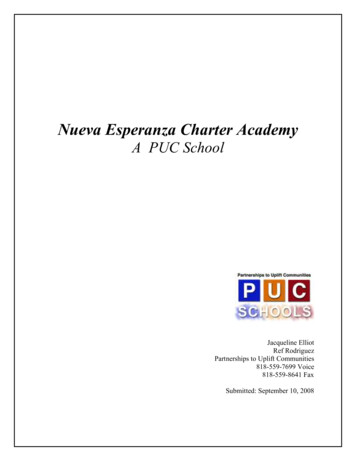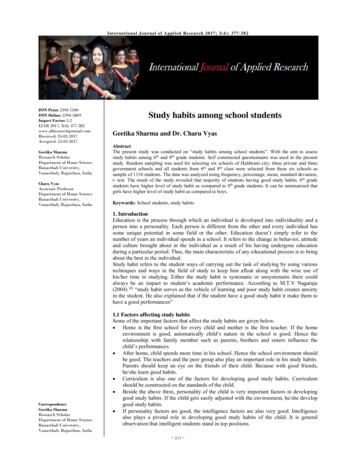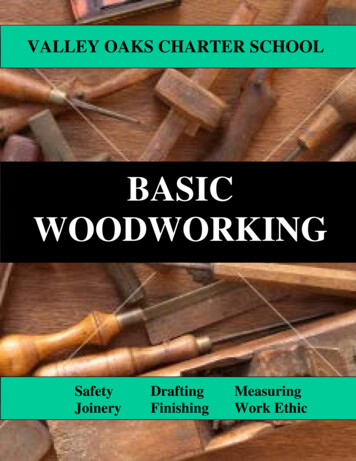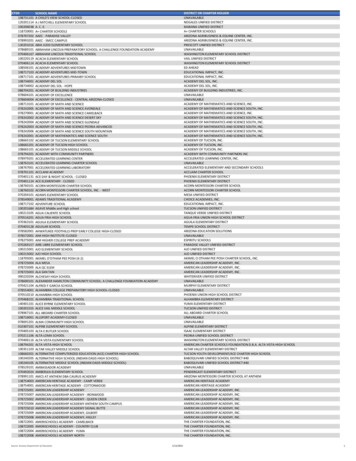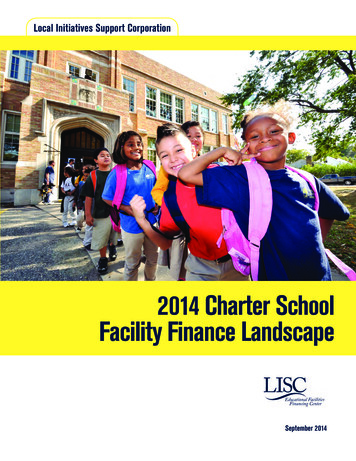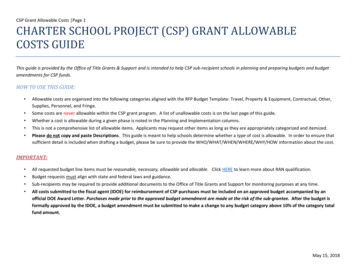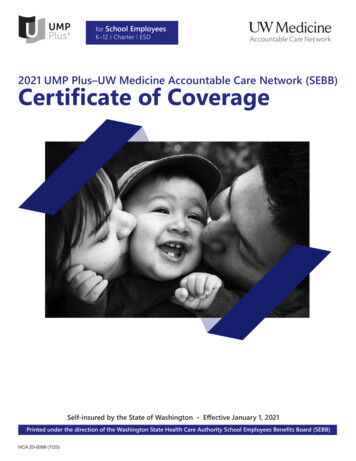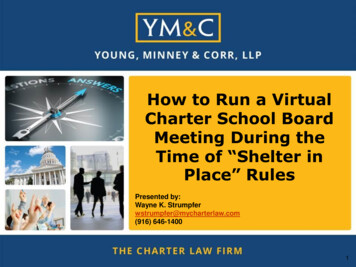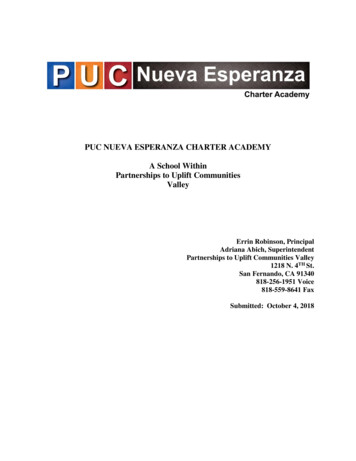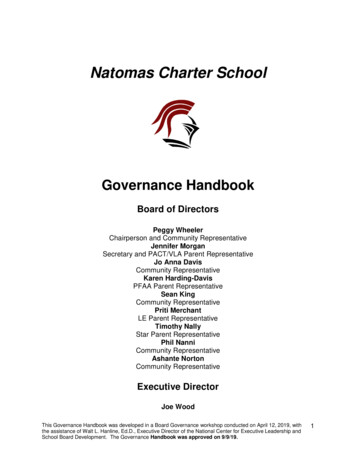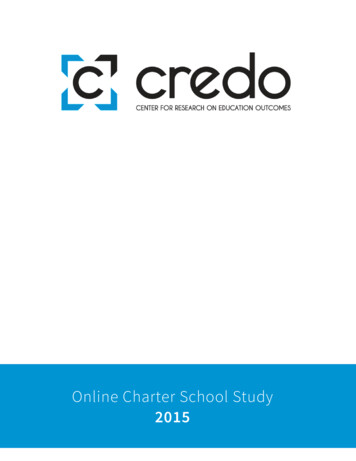
Transcription
Online Charter School Study2015
Online Charter School Study2015James L. Woodworth, Ph.D. – Lead AnalystMargaret E. Raymond, Ph.D. – Project DirectorKurt Chirbas – Graphics and FiguresMaribel Gonzalez – Data CollectionYohannes Negassi, M.A. – Research AnalystWill Snow, M.A. – Database ManagerChristine Van Donge, Ph.D. – Research Analyst
2015 CREDOCenter for Research on Education OutcomesStanford UniversityStanford, CAhttp://credo.stanford.eduCREDO, the Center for Research on Education Outcomes at Stanford University, was established toimprove empirical evidence about education reform and student performance at the primary andsecondary levels. CREDO at Stanford University supports education organizations and policymakers inusing reliable research and program evaluation to assess the performance of education initiatives.CREDO’s valuable insight helps educators and policymakers strengthen their focus on the results frominnovative programs, curricula, policies and accountability practices.AcknowledgementsCREDO gratefully acknowledges the support of the State Education Agencies and School Districts whocontributed their data to this partnership. Our data access partnerships form the foundation of CREDO'swork, without which studies like this would be impossible. We strive daily to justify the confidence youhave placed in us.CREDO also acknowledges the support of the Walton Family Foundation for this research.The views expressed herein do not necessarily represent the positions or policies of the organizationsnoted above. No official endorsement of any product, commodity, service or enterprise mentioned in thispublication is intended or should be inferred. The analysis and conclusions contained herein areexclusively those of the authors, are not endorsed by any of CREDO’s supporting organizations, theirgoverning boards, or the state governments, state education departments or school districts thatparticipated in this study. The conclusions of this research do not necessarily reflect the opinions orofficial position of the Texas Education Agency, the Texas Higher Education Coordinating Board, or theState of Texas.credo.stanford.edui
Table of Contents1. Introduction . 1Purpose of Study . 1Need for the Study . 1Questions to Be Addressed . 22. Methods and Data . 4Identifying Online Charter Schools . 4Consolidating Student Data from Multiple States . 5Multiple Datasets . 6Matched Data . 6Selection of Comparison Observations. 6Brick-District VCR Matched Sample . 8Mobility Study Data Set . 10Basic Analytic Model . 11Mixed Methods Analysis . 14Presentation of Results . 153. Student Mobility . 16Characteristics of Online Charter Mobility . 16Mobility and Student Characteristics . 20Mobility by Race-Ethnicity . 20Mobility by Student Sub-populations . 214. Impact Analysis . 23Online Charter Students Compared to Brick-District Students . 23Results by State. 25Sub-populations . 27Race-ethnicity . 27Students in Poverty. 28English language learners . 29Special education students . 30Interpretation of Subpopulation Effects . 31Online Charter Schools Compared to Brick-District Schools . 35Network Affiliation . 37Online Charter Students Compared to Brick-Charter Students . 39Mixed-Methods Analyses . 40Student Testing Data and School Survey Data . 40Self-Paced Delivery . 41credo.stanford.eduii
Synchronous vs. Asynchronous . 42Class Size . 43School and Family Interactions . 43Methods of Class Communication . 47School-Level Data and School Survey Data . 49School-Wide Policies. 49Student Support Activities . 52School and Family Interactions . 55Professional Development and Compensation . 55Non-Significant Findings . 59Student Testing Data and Policy Changes . 59Summary and Implications . 61Implications . 63Appendix A: DESCRIPTIVE PROFILE OF ONLINE CHARTER STUDENTS . 64Appendix B: TECHNICAL APPENDIX . 68Empirical Bayesian Shrinkage . 69Alternative Specifications . 71Brick-and-Mortar Charter School VCR . 71Generalized OLS Model on Multi-Year Panel Data . 73Restricted OLS Model on Multi-Year Panel Data . 74Online Charter School Choice Analysis . 76Appendix C: CORRELATES OF SCHOOL-LEVEL EFFECTS WITH SURVEY REPSONSES . 81References . 104credo.stanford.eduiii
Table of FiguresFigure 1: CREDO VCR Methodology . 8Figure 2: Mobility Rates by Subpopulation . 22Figure 3: Impact of Online Charter Attendance on Average Student Academic Growth, Reading and Math. 23Figure 4: Impact of Online Charter Attendance on Academic Growth by Year, Reading and Math . 24Figure 5: Online Charter Effect Size by State, Reading . 26Figure 6: Online Charter Effect Size by State, Math . 27Figure 7: Overall Academic Growth for Students in Poverty Compared to Students Not in Poverty, Readingand Math . 29Figure 8: Overall Academic Growth for English Language Learners Compared to Non-English LanguageLearners, Reading and Math . 30Figure 9: Overall Academic Growth for Special Education Students Compared to Non-Special EducationStudents, Reading and Math . 31Figure 10: Expected Values of Effect Sizes by Student Profile, Reading . 33Figure 11: Expected Values of Effect Sizes by Student Profile, Reading . 34Figure 12: Online Charter School Quality Curve: Reading and Math . 36Figure 13: Relationship between Growth and Attending an Online Charter School with Self-Paced Classes. 41Figure 14: Count of Schools by Number of Synchronous Hours of Instruction . 43Figure 15: Relationship between Monitoring Teacher/Family Interactions and Student Academic Growth. 44Figure 16: Relationship between Expected Parental Roles and Academic Growth, Reading . 46Figure 17: Relationship between Expected Parental Roles and Academic Growth, Math . 47Figure 18: Race-Ethnicity of Brick-District VCR Matched Sample Data Set, Math . 65Figure 19: Brick-District VCR Matched Sample Sub-Populations by Year, Math . 66Figure 20: Pre-Online Achievement Decile of Online Charter Students, Math . 67Figure 21: Online Charter Effect Size by State for Online Charter vs. Brick-Charter, Reading . 72Figure 22: Online Charter Effect Size by State for Online Charter vs.
CREDO at Stanford University supports education organizations and policymakers in using reliable research and program evaluation to assess the performance of education initiatives. CREDO’s valuable insight helps educators and policymakers strengthen their focus on the results from innovative programs, curricula, policies and accountability practices. Acknowledgements . CREDO gratefully .
